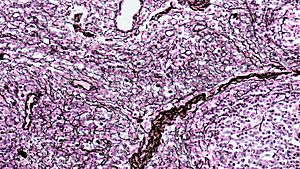Connective tissue facts for kids
Connective tissue is like the "glue" that holds your body together! It's a type of tissue that helps connect, support, and protect different parts of your body. It's one of the four main types of tissues, along with epithelial, muscle, and nervous tissue.
You can find connective tissue (often called CT) all over your body. It's made of three main parts: cells, fibres, and a special "goo" called the extracellular matrix.
Connective tissue forms many important body parts. These include tendons (which connect muscles to bones), blood vessels, cartilage (like in your nose and ears), bones, adipose tissue (fat), and lymphatic tissue (part of your immune system). There are different types, but they all help support and connect things.
Did you know that Collagen is a super important protein in connective tissue? It's the most common protein in animals, especially in mammals like us. Collagen makes up about a quarter of all the protein in our bodies!
Contents
What Makes Connective Tissue Special?
Connective tissue has some unique features that help it do its job:
- Cells are Spread Out: Unlike other tissues where cells are tightly packed, connective tissue cells are spread out. They float in a special fluid called the extracellular fluid.
- Ground Substance: This is a clear, colorless fluid. It helps hold body water and Collagen fibers in the spaces between cells. The ground substance also helps slow down the spread of pathogens (germs) in your body.
- The Matrix: Both the ground substance and the protein fibers work together. They create the "matrix," which is the main part of connective tissue. It gives the tissue its strength and flexibility.
Types of Fibers in Connective Tissue
Connective tissue contains different types of fibers, each with a special role:
- Collagenous Fibers: These are strong fibers that help bind bones and other tissues together. You can find them in places like tendons, ligaments, skin, and bones.
- Elastic Fibers: As their name suggests, these fibers are stretchy! They allow organs like your arteries and lungs to stretch and then return to their original shape.
- Reticular Fibers: These fibers form a delicate network or "scaffolding." They provide support for other cells, especially in organs like the liver, bone marrow, and parts of your immune system.
How Connective Tissue Helps Your Body
Connective tissue has many important jobs, depending on the types of cells and fibers it contains.
One key role of loose and dense connective tissue is to help your cells get what they need. They allow oxygen and nutrients to move into cells through a process called diffusion. They also help carbon dioxide and waste products move out of cells and back into your bloodstream.
Connective tissues also help your organs resist stretching and tearing. For example, dense connective tissue is a major part of your tendons and ligaments, which need to be very strong. It's even found in specialized parts like the cornea of your eye!
Images for kids
See also
 In Spanish: Tejido conjuntivo para niños
In Spanish: Tejido conjuntivo para niños


